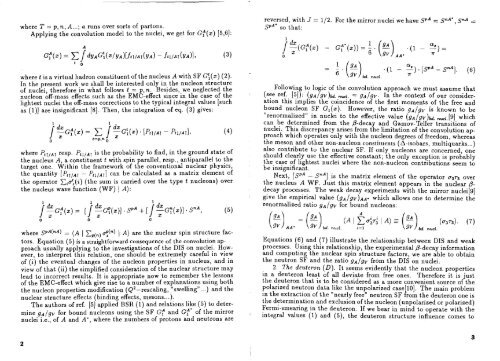Bjorken Sum Rule and Deep Inelastic Scattering on Polarized ... - JINR
Bjorken Sum Rule and Deep Inelastic Scattering on Polarized ... - JINR
Bjorken Sum Rule and Deep Inelastic Scattering on Polarized ... - JINR
Create successful ePaper yourself
Turn your PDF publications into a flip-book with our unique Google optimized e-Paper software.
where T = p, n, A...; a runs over sorts of part<strong>on</strong>s.<br />
Applying the c<strong>on</strong>voluti<strong>on</strong> model to the nuclei, we get for Gf(x) [5,6]:<br />
reversed, with J = 112. For the mirror nuclei we have<br />
SPA* SO that:<br />
= snA*, SnA =<br />
0<br />
1<br />
d~ 1 a8<br />
- x - ( x ) )<br />
= - . ( ) . (1 - -) =<br />
6<br />
AA'<br />
X<br />
where t is a virtual hadr<strong>on</strong> c<strong>on</strong>stituent of the nucleus A with SF Gi(x) (2).<br />
In the present work we shall be interested <strong>on</strong>ly in the nucle<strong>on</strong> structure<br />
of nuclei, therefore in what follows t = p, n. Besides, we neglected the<br />
nucle<strong>on</strong> off-mass effects such as the EMC-effect since in the case of the<br />
lightest nuclei the off-mass correcti<strong>on</strong>s to the typical integral values [such<br />
as (I)] are insignificant [8]. Then, the integrati<strong>on</strong> of eq. (3) gives:<br />
where PtTIAT resp. PtlIAT 5s the probability to find, in the ground state of<br />
the nucleus A, a c<strong>on</strong>stituent t with spin parallel, resp., antiparallel to the<br />
target <strong>on</strong>e. Withie the framework of the c<strong>on</strong>venti<strong>on</strong>al nuclear physics,<br />
the quantity [PtTIAT - PtlIAT] can be calculated as a matrix element of<br />
the operator Ciu',(i) (the sum is carried over the type t nucle<strong>on</strong>s) over<br />
the nucleus wave functi<strong>on</strong> (WF) I A):<br />
where = (A 1 Cp(,,) u$") I A) are the nuclear spin structure fat-<br />
. .<br />
tors. Equati<strong>on</strong> (5) is a straightforward c<strong>on</strong>sequence of the c<strong>on</strong>voluti<strong>on</strong> approach<br />
usually applying to the investigati<strong>on</strong>s of the DIS <strong>on</strong> nuclei. However,<br />
to interpret this relati<strong>on</strong>, <strong>on</strong>e should be extremely careful in view<br />
of (i) the eventual changes of the nucle<strong>on</strong> properties in nucleus, <str<strong>on</strong>g>and</str<strong>on</strong>g> in<br />
view of that (ii) the simplified c<strong>on</strong>siderati<strong>on</strong> of the nuclear structure may<br />
lead to incorrect results. It is appropriate now to remember the less<strong>on</strong>s<br />
of the EMC-effect which give rise to a number of explanati<strong>on</strong>s using both<br />
the nucle<strong>on</strong> properties modificati<strong>on</strong> (Q2-resealing, "swelling". ..) <str<strong>on</strong>g>and</str<strong>on</strong>g> the<br />
nuclear structure effects (binding effects, mes<strong>on</strong>s...).<br />
The authors of ref. [5] applied BSR (1) <str<strong>on</strong>g>and</str<strong>on</strong>g> relati<strong>on</strong>s like (5) to determine<br />
gAlgv for bound nucle<strong>on</strong>s using the SF Gf <str<strong>on</strong>g>and</str<strong>on</strong>g> Gf' of the mirror<br />
nuclei i.e., of A <str<strong>on</strong>g>and</str<strong>on</strong>g> A', where the numbers of prot<strong>on</strong>s <str<strong>on</strong>g>and</str<strong>on</strong>g> neutr<strong>on</strong>s are<br />
Following to logic of the c<strong>on</strong>voluti<strong>on</strong> approach we must assume that<br />
(see ref. [5]): (gA/gv)bd. nucl. = g~/gv. In the c<strong>on</strong>text of our c<strong>on</strong>siderati<strong>on</strong><br />
this implies the coincidence of the first moments of the free <str<strong>on</strong>g>and</str<strong>on</strong>g><br />
bound nucle<strong>on</strong> SF Gl(x). However, the ratio gA/gV is known to be<br />
"renormalized" in nuclei to the effective value (gA/gV)bd. nucl.[9] which<br />
can be determined from the 0-decay <str<strong>on</strong>g>and</str<strong>on</strong>g> Gamov-Teller transiti<strong>on</strong>s of<br />
nuclei. This discrepancy arises from the limitati<strong>on</strong> of the c<strong>on</strong>voluti<strong>on</strong> approach<br />
which operates <strong>on</strong>ly with the nucle<strong>on</strong> degrees of freedom, whereas<br />
the mes<strong>on</strong> <str<strong>on</strong>g>and</str<strong>on</strong>g> other n<strong>on</strong>-nucle<strong>on</strong> c<strong>on</strong>stituents (A-isobars, multiquarks ...)<br />
also c<strong>on</strong>tribute to the nuclear SF. If <strong>on</strong>ly nucle<strong>on</strong>s are c<strong>on</strong>cerned, <strong>on</strong>e<br />
should clearly use the effective c<strong>on</strong>stant; the <strong>on</strong>ly excepti<strong>on</strong> is probably<br />
the case of lightest nuclei where the n<strong>on</strong>-nucleorr c<strong>on</strong>tributioes seem to<br />
be insignificant.<br />
Next, [SPA- SnA] is the matrix element of the operator u373 over<br />
the nucleus A WF. Just this matrix element appears in the nuclear 0-<br />
decay processes. The weak decay experiments with the mirror nuclei[9]<br />
give the empirical value (gA/gV)AA* which allows <strong>on</strong>e to determine the<br />
renormalized ratio gA/gv for bound nucle<strong>on</strong>s:<br />
(:)AA.<br />
= (E)<br />
A<br />
bd. nucl. (A I i=l Cujrj 1 A) bd. nucl.<br />
Equati<strong>on</strong>s (6) <str<strong>on</strong>g>and</str<strong>on</strong>g> (7) illustrate the relati<strong>on</strong>ship between DIS <str<strong>on</strong>g>and</str<strong>on</strong>g> weak<br />
processes. Using this relati<strong>on</strong>ship, the experimental 0-decay informati<strong>on</strong><br />
<str<strong>on</strong>g>and</str<strong>on</strong>g> computing the nuclear spin structure factors, we are able to obtain<br />
the neutr<strong>on</strong> SF <str<strong>on</strong>g>and</str<strong>on</strong>g> the ratio gA/gv from the DIS <strong>on</strong> nuclei.<br />
2. The deuter<strong>on</strong> (D). It seems evidently that the nucle<strong>on</strong> properties<br />
in a deuter<strong>on</strong> least of all deviate from free <strong>on</strong>es. Therefore it is just<br />
the deuter<strong>on</strong> that is to be c<strong>on</strong>sidered as a more c<strong>on</strong>venient source of the<br />
polarized neutr<strong>on</strong> data like the unpolarized case[lO]. The main problem<br />
in the extracti<strong>on</strong> of the "nearly free" neutr<strong>on</strong> SF from the deuter<strong>on</strong> <strong>on</strong>e is<br />
the determinati<strong>on</strong> <str<strong>on</strong>g>and</str<strong>on</strong>g> exclusi<strong>on</strong> of the nucle<strong>on</strong> (unpolarized or polarized)<br />
Fermi-smearing in the deuter<strong>on</strong>. If we bear in mind to operate with the<br />
integral values (1) <str<strong>on</strong>g>and</str<strong>on</strong>g> (5), the deuter<strong>on</strong> structure influence comes to

















